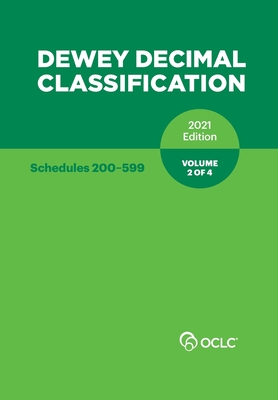DEWEY DECIMAL CLASSIFICATION, 2021 (Schedules 200-599) (Volume 2 of 4)

DEWEY DECIMAL CLASSIFICATION, 2021 (Schedules 200-599) (Volume 2 of 4)
2021 version of the Dewey Decimal Classification.DEWEY DECIMAL CLASSIFICATION, 2021 (200-599) (Volume 2 of 4)
Classification: What It Is and What It Does Classification provides a system for organizing knowledge. Classification may be used to organize knowledge represented in any form, e.g., books, documents, electronic resources. Notation is the system of symbols used to represent the classes in a classification system. In the Dewey Decimal Classification, the notation is expressed in Arabic numerals. The notation gives both the unique meaning of the class and its relation to other classes. The notation provides a universal language to identify the class and related classes, regardless of the fact that different words or languages may be used to describe the class.
History, Current Use, and Development of the Dewey Decimal Classification The Dewey Decimal Classification-conceived by Melvil Dewey in 1873 and first published in 1876-is a general knowledge organization tool that is continuously revised to keep pace with knowledge. The system is further extended through number building, interoperable translations, association with categorized content, and mappings to other subject schemes. The DDC is published by OCLC, Inc. The DDC is accessed through WebDewey, a frequently updated subscription service maintained by OCLC. OCLC owns all copyright rights in the Dewey Decimal Classification and licenses the system for a variety of uses. The DDC is the most widely used classification system in the world. Libraries in more than 138 countries use the DDC to organize and provide access to their collections, and DDC numbers are featured in the national bibliographies of more than sixty countries. Libraries of every type apply Dewey numbers on a daily basis and share these numbers through a variety of means (including WorldCat). Dewey is also used in a variety of applications on the web in support of categorization, browsing, and retrieval.
The DDC has been translated into over thirty languages. Since 1988, authorized translations of the full and abridged editions of the DDC have been published or are under way in Arabic, French, German, Greek, Hebrew, Icelandic, Indonesian, Italian, Norwegian, Russian, Spanish, Swedish, Turkish, and Vietnamese. The DDC Summaries, the top three levels of the Dewey Decimal Classification system, have been translated into Afrikaans, Arabic, Chinese, Czech, French, German, Hebrew, Italian, Norwegian, Portuguese, Russian, S
PRP: 1090.93 Lei
Acesta este Pretul Recomandat de Producator. Pretul de vanzare al produsului este afisat mai jos.
981.84Lei
981.84Lei
1090.93 LeiIndisponibil
Descrierea produsului
2021 version of the Dewey Decimal Classification.DEWEY DECIMAL CLASSIFICATION, 2021 (200-599) (Volume 2 of 4)
Classification: What It Is and What It Does Classification provides a system for organizing knowledge. Classification may be used to organize knowledge represented in any form, e.g., books, documents, electronic resources. Notation is the system of symbols used to represent the classes in a classification system. In the Dewey Decimal Classification, the notation is expressed in Arabic numerals. The notation gives both the unique meaning of the class and its relation to other classes. The notation provides a universal language to identify the class and related classes, regardless of the fact that different words or languages may be used to describe the class.
History, Current Use, and Development of the Dewey Decimal Classification The Dewey Decimal Classification-conceived by Melvil Dewey in 1873 and first published in 1876-is a general knowledge organization tool that is continuously revised to keep pace with knowledge. The system is further extended through number building, interoperable translations, association with categorized content, and mappings to other subject schemes. The DDC is published by OCLC, Inc. The DDC is accessed through WebDewey, a frequently updated subscription service maintained by OCLC. OCLC owns all copyright rights in the Dewey Decimal Classification and licenses the system for a variety of uses. The DDC is the most widely used classification system in the world. Libraries in more than 138 countries use the DDC to organize and provide access to their collections, and DDC numbers are featured in the national bibliographies of more than sixty countries. Libraries of every type apply Dewey numbers on a daily basis and share these numbers through a variety of means (including WorldCat). Dewey is also used in a variety of applications on the web in support of categorization, browsing, and retrieval.
The DDC has been translated into over thirty languages. Since 1988, authorized translations of the full and abridged editions of the DDC have been published or are under way in Arabic, French, German, Greek, Hebrew, Icelandic, Indonesian, Italian, Norwegian, Russian, Spanish, Swedish, Turkish, and Vietnamese. The DDC Summaries, the top three levels of the Dewey Decimal Classification system, have been translated into Afrikaans, Arabic, Chinese, Czech, French, German, Hebrew, Italian, Norwegian, Portuguese, Russian, S
Detaliile produsului









